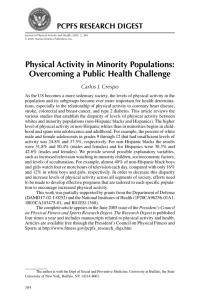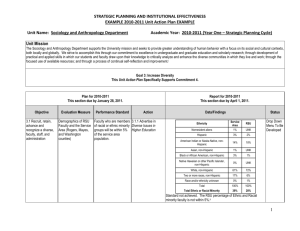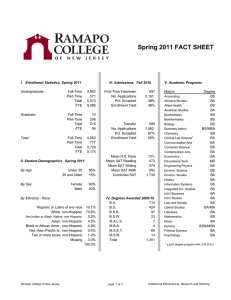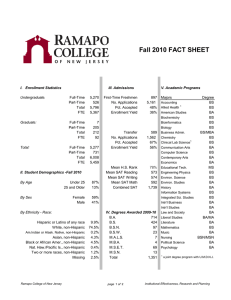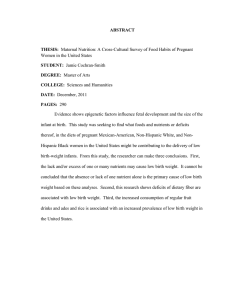The Black Population in the United States: March 2002 Population Characteristics Current
advertisement
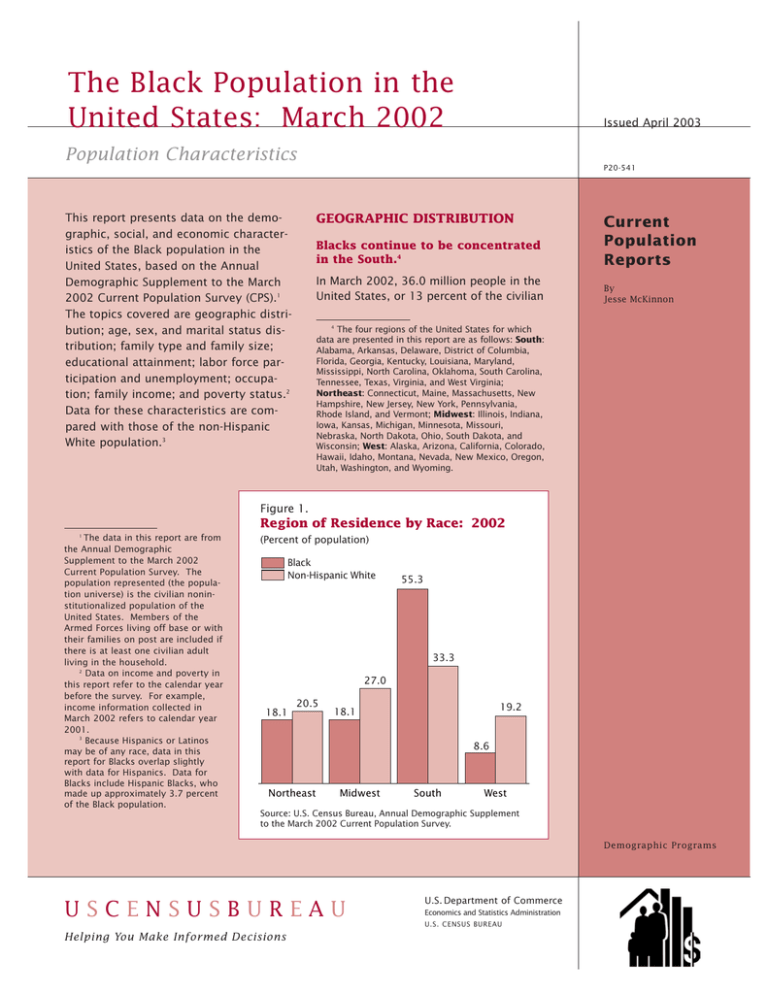
The Black Population in the United States: March 2002 Issued April 2003 Population Characteristics P20-541 GEOGRAPHIC DISTRIBUTION This report presents data on the demographic, social, and economic characteristics of the Black population in the United States, based on the Annual Demographic Supplement to the March 2002 Current Population Survey (CPS).1 The topics covered are geographic distribution; age, sex, and marital status distribution; family type and family size; educational attainment; labor force participation and unemployment; occupation; family income; and poverty status.2 Data for these characteristics are compared with those of the non-Hispanic White population.3 Blacks continue to be concentrated in the South.4 Current Population Reports In March 2002, 36.0 million people in the United States, or 13 percent of the civilian By Jesse McKinnon 4 The four regions of the United States for which data are presented in this report are as follows: South: Alabama, Arkansas, Delaware, District of Columbia, Florida, Georgia, Kentucky, Louisiana, Maryland, Mississippi, North Carolina, Oklahoma, South Carolina, Tennessee, Texas, Virginia, and West Virginia; Northeast: Connecticut, Maine, Massachusetts, New Hampshire, New Jersey, New York, Pennsylvania, Rhode Island, and Vermont; Midwest: Illinois, Indiana, Iowa, Kansas, Michigan, Minnesota, Missouri, Nebraska, North Dakota, Ohio, South Dakota, and Wisconsin; West: Alaska, Arizona, California, Colorado, Hawaii, Idaho, Montana, Nevada, New Mexico, Oregon, Utah, Washington, and Wyoming. Figure 1. Region of Residence by Race: 2002 The data in this report are from the Annual Demographic Supplement to the March 2002 Current Population Survey. The population represented (the population universe) is the civilian noninstitutionalized population of the United States. Members of the Armed Forces living off base or with their families on post are included if there is at least one civilian adult living in the household. 2 Data on income and poverty in this report refer to the calendar year before the survey. For example, income information collected in March 2002 refers to calendar year 2001. 3 Because Hispanics or Latinos may be of any race, data in this report for Blacks overlap slightly with data for Hispanics. Data for Blacks include Hispanic Blacks, who made up approximately 3.7 percent of the Black population. 1 (Percent of population) Black Non-Hispanic White 55.3 33.3 27.0 18.1 20.5 19.2 18.1 8.6 Northeast Midwest South West Source: U.S. Census Bureau, Annual Demographic Supplement to the March 2002 Current Population Survey. Demographic Programs USCENSUSBUREAU U.S. Department of Commerce Economics and Statistics Administration U.S. CENSUS BUREAU Helping You Make Informed Decisions noninstitutionalized population, were Black. The majority of Blacks lived in the South (55 percent), a similar proportion (18 percent) lived in the Northeast and the Midwest, and 9 percent lived in the West (see Figure 1).5 In comparison, 69 percent (194.8 million) of the United States population was non-Hispanic White: 33 percent lived in the South, 27 percent in the Midwest, 21 percent in the Northeast, and 19 percent in the West. Over one-half (52 percent) of all Blacks lived in a central city within a metropolitan area,6 compared with 21 percent of non-Hispanic Whites. In contrast, 57 percent of non-Hispanic Whites lived outside the central city but within the metropolitan area, compared with 36 percent of Blacks. Only 13 percent of Blacks and 22 percent of non-Hispanic Whites lived in nonmetropolitan areas (see Figure 2). AGE, SEX, AND MARITAL STATUS DISTRIBUTION Figure 2. Metropolitan and Nonmetropolitan Residence by Race: 2002 (Percent distribution of population) 12.5 22.1 Nonmetropolitan 56.8 Metropolitan area, outside central city 21.1 Metropolitan area, inside central city 36.0 51.5 Non-Hispanic White Black Source: U.S. Census Bureau, Annual Demographic Supplement to the March 2002 Current Population Survey. Figure 3. Population by Age, Sex, and Race: 2002 (Percent of population) The Black population is younger than the non-Hispanic White population. In 2002, 33 percent of all Blacks were under 18, compared with 23 percent of non-Hispanic Whites. Only 8 percent of Blacks were 65 and older, compared with 14 percent of non-Hispanic Whites. Black Non-Hispanic White 35.5 29.9 23.9 21.7 16.2 12.4 9.0 The estimates in this report are based on responses from a sample of the population. As with all surveys, estimates may vary from the actual values because of sampling variation or other factors. All comparisons made in this report have undergone statistical testing and are significant at the 90-percent confidence level unless otherwise noted. 6 The general concept of a metropolitan area (MA) is a large population nucleus with adjacent communities that have a high degree of economic and social integration with that nucleus. Some MAs are defined around two or more nuclei. The Office of Management and Budget (OMB), with technical assistance from the U.S. Census Bureau, published standards to define MAs for federal agencies. See the Office of Management and Budget, Federal Register Notice, Vol. 55, No. 62, March 30, 1990, and OMB Bulletin, No. 93177, issued June 1993. 6.7 5 2 Under 18 65 and over Male Under 18 65 and over Female Source: U.S. Census Bureau, Annual Demographic Supplement to the March 2002 Current Population Survey. A larger proportion of Black males than non-Hispanic White males were under 18 (36 percent compared with 24 percent). In contrast, 7 percent of Black males and 12 percent of non-Hispanic White males were 65 and over. A greater percentage of Black females (30 percent) than non-Hispanic White females (22 percent) were under age 18, while 9 percent of Black females and 16 percent of U.S. Census Bureau Figure 4. Marital Status by Sex and Race: 2002 Black Non-Hispanic White (Percent of population 15 and over) 59.3 55.1 45.0 42.0 39.8 31.1 28.0 21.3 9.4 8.3 8.8 4.1 Never married Married 1.3 5.4 2.7 2.7 Separated Widowed Divorced 10.9 12.2 11.1 1.6 Never married Married Men Separated Widowed Divorced Women Source: U.S. Census Bureau, Annual Demographic Supplement to the March 2002 Current Population Survey. non-Hispanic White females were 65 and over (see Figure 3). Blacks are less likely to be married than non-Hispanic Whites. Among the 26.2 million Blacks and the 158.3 million non-Hispanic Whites 15 and older, 10 percent of each were divorced and about 6 percent of each were widowed, but 43 percent of Blacks had never married, compared with 25 percent of non-Hispanic Whites. Blacks were less likely than their nonHispanic White counterparts to be currently married (35 percent and 57 percent, respectively).7 The marital distributions of Blacks and non-Hispanic Whites varied by sex. In 2002, in both groups, women were more likely than men to be widowed, separated, or divorced, and less likely to be never married or currently married (see Figure 4). Black men were Married includes those with a spouse present or a spouse absent. 7 U.S. Census Bureau more likely than their non-Hispanic White counterparts to be never married: 45 percent and 28 percent, respectively. The comparable figures for women were 42 percent and 21 percent. FAMILY TYPE AND FAMILY SIZE8 Fewer Black families are married-couple families. In 2002, there were 8.8 million Black families and 53.6 million nonHispanic White families in the United States. Nearly one-half (48 percent) of all Black families were married-couple families, 43 percent of Black families were maintained by women with no spouse present, and 9 percent were maintained by Black men with no spouse present. The corresponding figures for non-Hispanic White families were 82 percent, 13 percent, and 5 percent, respectively. 8 The race of the householder was used to determine the race of the family. Data do not include families in group quarters. Black families are larger than non-Hispanic White families. In 2002, among married-couple families, 33 percent of Black families had two members, compared with 47 percent of non-Hispanic White families (see Figure 5). Black married-couple families were more likely than their non-Hispanic White counterparts to have five or more members (20 percent and 12 percent, respectively). Among families maintained by women with no spouse present, 40 percent of Black families had two members, compared with 55 percent of nonHispanic White families. The proportions of Black and non-Hispanic White families maintained by women with five or more members were 11 percent and 5 percent, respectively. Fifty-seven percent of Black male householder families with no spouse present consisted of two people compared with 61 percent of non-Hispanic White male householder families. Six percent of Black families maintained by men with no spouse present had five or 3 Figure 5. Family Size by Family Type and Race of Householder: 2002 (Percent distribution of families) Two members Three members Four members Five or more members Married couple 33.2 Black Non-Hispanic White 22.4 47.0 24.5 19.9 19.7 21.2 12.1 Female householder, no spouse present 39.7 Black Non-Hispanic White 31.1 18.3 54.9 10.9 29.6 10.7 4.8 Male householder, no spouse present Black Non-Hispanic White 57.0 25.6 61.2 11.6 26.0 5.8 4.3 8.5 Source: U.S. Census Bureau, Annual Demographic Supplement to the March 2002 Current Population Survey. more members, compared with 4 percent of comparable nonHispanic White families. EDUCATIONAL ATTAINMENT More Black women than Black men aged 25 and over have earned at least a bachelor’s degree. Of the 20.4 million Blacks and 133.4 million non-Hispanic Whites 25 and older, a lower percentage of Blacks had earned at least a high school diploma (79 percent and 89 percent, respectively). The proportion of all non-Hispanic Whites with at least a bachelor’s degree (29 percent) was higher than that of all Blacks (17 percent). More Black women than Black men had earned at least a bachelor’s degree (18 percent compared with 16 percent, see Figure 6), while among non-Hispanic Whites, a higher proportion of men than women had earned at least a bachelor’s degree (32 percent and 27 percent, respectively). 4 Figure 6. Educational Attainment by Sex and Race: 2002 (Percent of population 25 and over) Black Non-Hispanic White Men 21.5 Less than high school 11.5 34.8 High school graduate 31.5 27.3 Some college or associate degree 25.2 16.4 Bachelor's degree or more 31.7 Women Less than high school 21.1 11.1 33.3 High school graduate 34.3 28.2 Some college or associate degree Bachelor's degree or more 27.3 17.5 27.3 Source: U.S. Census Bureau, Annual Demographic Supplement to the March 2002 Current Population Survey. U.S. Census Bureau Figure 7. Civilian Labor Force Participation Rate and Unemployment Rate by Sex and Race: 2002 Black Non-Hispanic White 73.4 68.1 62.3 59.9 11.9 9.9 5.7 Men Women Percent in civilian labor force of population 16 years and over Men 4.4 Women Percent unemployed of civilian labor force Source: U.S. Census Bureau, Annual Demographic Supplement to the March 2002 Current Population Survey. LABOR FORCE PARTICIPATION AND UNEMPLOYMENT Blacks participate in the labor force at a lower rate than nonHispanic Whites. Among the 216.8 million members of the civilian population aged 16 and over in 2002, 25.4 million (12 percent) were Black and 155.1 million (72 percent) were non-Hispanic White. Non-Hispanic White men had a higher civilian labor force participation rate than Black men (73 percent compared with 68 percent), and for both groups, men had higher rates than women.9 However, the rate for 9 Civilian labor force data shown in this report reflect characteristics of the civilian noninstitutionalized population aged 16 and older for March 2002 and are not adjusted for seasonal changes. Data released by the Department of Labor, Bureau of Labor Statistics may not agree entirely with data shown in this report because they are seasonally adjusted. U.S. Census Bureau aged 16 and older were employed. Similar proportions of Black and non-Hispanic White men were employed in technical, sales, and administrative support jobs (about 20 percent). However, the proportion of non-Hispanic White men employed in managerial and professional specialty occupations (33 percent) was higher than that of Black men (18 percent). A larger proportion of non-Hispanic White men than Black men were employed in precision production, craft, and repair jobs (19 percent and 14 percent, respectively). However, Black men were more than twice as likely as non-Hispanic White men to work in service occupations (19 percent and 8 percent, respectively). They were nearly twice as likely (28 percent compared with 16 percent) to be operators, fabricators, and laborers. Black women (62 percent) was higher than that for non-Hispanic White women (60 percent, see Figure 7). Unemployment is higher among Blacks than non-Hispanic Whites. In March 2002, the unemployment rate for Blacks was twice that for non-Hispanic Whites (11 percent and 5 percent, respectively). This finding was consistent for both men (12 percent compared with 6 percent) and women (10 percent compared with 4 percent). Non-Hispanic White women were more likely than Black women to be in managerial and professional specialty jobs (37 percent compared with 26 percent), as well as in technical, sales, and administrative support jobs (40 percent and 36 percent, respectively). Conversely, Black women were more likely than non-Hispanic White women to be employed in service occupations (27 percent compared with 15 percent), or as operators, fabricators, and laborers (9 percent compared with 5 percent). FAMILY INCOME11 OCCUPATION10 Over one-half (52 percent) of all Black married-couple families had incomes of $50,000 or more. Similar proportions of Black and non-Hispanic White men were employed in technical, sales, and administrative support jobs. Of the 74.3 million families in 2001 with money income, 8.8 million were Black and 53.6 million were non-Hispanic White. Thirty-three In 2002, 6.8 million Black men and 51.8 million non-Hispanic White men 10 The data on current occupation are for the employed civilian population aged 16 and older. 11 Data for all families include a small number in group quarters. Income is the sum of wages and salaries, net income from selfemployment, and income other than earnings. Income data refer to calendar year 2001. 5 Figure 8. Family Income by Family Type and Race of Householder: 2001 (Percent distribution of families) Less than $25,000 $25,000$34,999 $35,000$49,999 $50,000$74,999 $75,000 and over Married couple Black Non-Hispanic White 18.8 11.8 11.6 9.6 17.1 15.0 25.5 26.9 23.5 40.1 Female householder, no spouse present 58.1 Black Non-Hispanic White 15.7 41.1 17.2 12.6 17.6 9.0 4.7 13.5 10.5 14.6 10.9 Male householder, no spouse present 37.6 Black Non-Hispanic White 24.5 18.9 16.8 17.9 20.1 19.5 19.1 Source: U.S. Census Bureau, Annual Demographic Supplement to the March 2002 Current Population Survey. percent of all Black families and 57 percent of all non-Hispanic White families had incomes of $50,000 or more. The percent of non-Hispanic White families making $75,000 or more was over twice that of Blacks: 35 percent compared with 16 percent. Among both Black and nonHispanic White families, marriedcouple families were more likely to have incomes of $50,000 or more. Fifty-two percent of Black marriedcouple families, compared with 64 percent of their non-Hispanic White counterparts, had incomes of $50,000 or greater (see Figure 8). Twenty-seven percent of all Black married-couple families had incomes of $75,000 or more, compared with 40 percent of comparable non-Hispanic White families. Both Black and non-Hispanic White families maintained by women with no spouse present were more likely to have incomes concentrated in the lower income ranges: 58 percent of Black families and 41 percent of non-Hispanic White families had incomes less than $25,000. 6 Both Black and non-Hispanic White families maintained by men with no spouse present were also more likely to have incomes less than $25,000 than in higher categories: 38 percent and 25 percent, respectively (see Figure 8). POVERTY STATUS12 Blacks accounted for about one quarter of the population in poverty in 2001. An estimated 32.9 million people lived below the poverty level in 2001, including 8.1 million Blacks and 15.3 million non-Hispanic Whites. The poverty rate, which was 12 percent for the total population, was 23 percent for Blacks and 8 percent for non-Hispanic Whites. Among all children under age 18, the poverty rate was 16 percent, 12 For more information, see Bernadette D. Proctor and Joseph Dalaker, 2002, U.S. Census Bureau, Current Population Reports, Series P60-219, Poverty in the United States: 2001, U.S. Government Printing Office, Washington, DC. Poverty data refer to calendar year 2001. but it was three times as high for Black children (30 percent) as for non-Hispanic White children (10 percent). The poverty rate among all people 65 and over was 10 percent in 2001. The poverty rates in this age group for Blacks and non-Hispanic Whites were 22 percent and 8 percent, respectively (see Figure 9). About 10 percent of all men were below the official poverty line in 2001, but the rate for Black men (20 percent) was nearly three times that for non-Hispanic White men (7 percent). Among men 65 and over, the rate for Blacks was three times as high (16 percent) as the rate for non-Hispanic Whites (5 percent, see Figure 10). In 2001, 13 percent of all women were poor. The poverty rate for Black women (25 percent) was more than twice that for nonHispanic White women (9 percent); for women 65 and older, the rates were 26 percent and 10 percent, respectively. U.S. Census Bureau Figure 9. Poverty Rate by Age and Race: 2001 (Percent of population) Total Black Non-Hispanic White 30.2 SOURCE OF THE DATA 22.7 21.9 16.3 11.7 10.1 9.5 7.8 All ages Under 18 8.1 65 and over Source: U.S. Census Bureau, Annual Demographic Supplement to the March 2002 Current Population Survey. Figure 10. Poverty Rate by Age, Sex, and Race: 2001 (Percent of population) Black Non-Hispanic White 30.7 29.7 26.1 24.9 20.1 9.6 All ages 8.8 9.5 All ages Under 18 10.2 5.2 Under 18 65 and over Male 65 and over Female Source: U.S. Census Bureau, Annual Demographic Supplement to the March 2002 Current Population Survey. Families maintained by women with no spouse present have higher poverty rates overall. In 2001, 6.8 million families in the United States had incomes below the poverty level. Of these families, 1.8 million were Black and 3.1 million were non-Hispanic White. U.S. Census Bureau The population represented (the population universe) in the Annual Demographic Supplement to the March 2002 Current Population Survey is the civilian noninstitutionalized population of the United States. Members of the Armed Forces living off post or with their families on post are included if there is at least one civilian adult living in the household. (Starting in 2001, the Annual Demographic Supplement includes some data collected in February and April.) The institutionalized population, which is excluded from the population universe, is composed primarily of the population in correctional institutions and nursing homes (91 percent of the 4.1 million institutionalized population in Census 2000). ACCURACY OF THE ESTIMATES 15.6 6.9 highest in families maintained by women with no spouse present: 35 percent for Black families compared with 19 percent for nonHispanic White families. Black families maintained by men with no spouse present were more likely to live in poverty (19 percent) than comparable non-Hispanic White families (10 percent). However, a greater percentage of Black families than of non-Hispanic White families were poor: 21 percent compared with 6 percent. A larger proportion of Black married-couple families (8 percent) than of non-Hispanic White families (3 percent) were poor. Poverty was Statistics from surveys are subject to sampling and nonsampling error. All comparisons presented in this report have taken sampling error into account and are significant at the 90-percent confidence level. This means the 90-percent confidence interval for the difference between the estimates being compared does not include zero. Nonsampling errors in surveys may be attributed to a variety of sources, such as how the survey was designed, how respondents interpret questions, how able and willing respondents are to provide correct answers, and how 7 accurately the answers are coded and classified. The Census Bureau employs quality control procedures throughout the production process including the overall design of surveys, the wording of questions, review of the work of interviewers and coders, and statistical review of reports to minimize these errors. The Current Population Survey weighting procedure uses ratio estimation whereby sample estimates are adjusted to independent estimates of the national population by age, race, sex, and Hispanic origin. This weighting partially corrects for bias due to undercoverage, but biases may still be present when people who are missed by the survey differ from those interviewed in ways other than age, race, sex, and Hispanic origin. How this weighting procedure affects other variables in the survey is not precisely known. All of these considerations affect comparisons across different surveys or data sources. For further information on statistical standards and the computation and use of standard errors, go to www.bls.census.gov/cps/ads/2002/ S&A_02.pdf or contact Brandi York of the Census Bureau’s Demographic Statistical Methods Division on the Internet at dsmd.source. and.accuracy@census.gov. contacting our Statistical Information Office. SUGGESTED CITATION MORE INFORMATION Detailed tables with social and economic characteristics of Black and other races, and their families and households are available on the Internet (www.census.gov); search by clicking on “B” for “Blacks” under the “Subjects A-Z” heading on the Census Bureau’s home page. To receive a paper copy of these tables, send your request for “PPL-164, The Black Population in the United States: March 2002” along with a check or money order in the amount of $22.10 payable to Commerce-Census-88-00-9010, to the U.S. Department of Commerce, U.S. Census Bureau, P.O. Box 277943, Atlanta, GA 30384-7943, or call our Statistical Information Office on 301-763-2422. A copy of these tabulations will be made available to any existing CPR-P20 subscriber without charge, provided that the request is made within 3 months of the issue date of this report by McKinnon, Jesse. 2003. The Black Population in the United States: March 2002. U.S. Census Bureau, Current Population Reports, Series P20-541. Washington, DC. CONTACTS Statistical Information Staff: pop@census.gov 301-763-2422 Racial Statistics Branch Jesse McKinnon Jesse.D.McKinnon@census.gov 301-763-2453. USER COMMENTS The Census Bureau welcomes the comments and advice of users of its data and reports. If you have any suggestions or comments, please write to: Chief, Population Division U.S. Census Bureau Washington, DC 20233 or send e-mail to: pop@census.gov Penalty for Private Use $300 OFFICIAL BUSINESS U.S. CENSUS BUREAU Washington, DC 20233 Economics and Statistics Administration U.S. Department of Commerce FIRST-CLASS MAIL POSTAGE & FEES PAID U.S. Census Bureau Permit No. G-58
